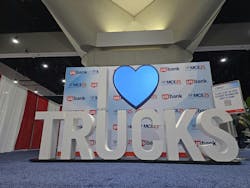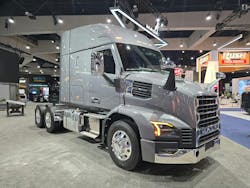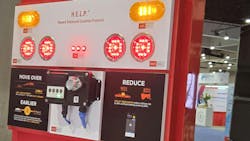ATA MCE Roundup: Recession repercussions, FET repeal, and latest equipment launches
Key Highlights
- Plenty of OEMs debuted or highlighted new solutions at the American Trucking Associations' Management Conference & Exhibition
- For new solutions, Clarios showed off its Battery Management solution to monitor truck battery health, while Grote Industries displayed its two collision-avoidance systems, H.E.L.P. DeliverSAFE and the 4SEE Rear-Collision Warning System. Transtex also highligted its Edge CabFlex
- And on the truck front, Mack emphasized its new Pioneer and Anthem trucks, while Volvo emphasized how its updated VNL and VNR are helping fleets save on fuel
Even if you could make it to the American Trucking Associations' 2025 Management Conference & Exhibition in San Diego this past October, you couldn't be everywhere at once. Luckily, the editorial teams for Fleet Maintenance and FleetOwner were wearing fairly comfortable shoes and made it to all the key events to cover for you.
Here's a roundup of what we thought you should know from the show.
Grim freight forecast
It was glaring how different the overall mood within the San Diego Convention Center was from the perfectly sunny seaside weather outside.
Maybe Bob Costello, ATA chief economist and SVP, had something to do with it. His market update portended a grim 2026 for carriers due to tariffs, which he called "a very blunt tool to try to achieve that free and fair trade."
And trying to bludgeon the problem of inequity between the U.S. and its trade partners will be painful. "There's going to be casualties, and it's going to hurt, especially around U.S. manufacturing,” Costello said.
This is one factor he believes will extend the freight recession and likely cull less profitbale fleets from the sector. He singled out fleets that have reduced spending by deferring maintenance. That's a temporary fix any vehicle owner knows has disastrous longterm consequences.
For more on the subject, and how the recession has extended trade cycles, listen to our podcast with Fleet Advantage's SVP of fleet operations, Brian Antonellis.
ATA's Spear bullish on Trump
ATA President and CEO Chris Spear did his best to rally attendees with a speech that really knew the audience, taking shots at trucking's softest of targets, including former president Joe Biden, the California Air Resources Board, and billboard lawyers pushing nuclear verdicts.
Meanwhile he lauded current Commander-in-Chief Donald Trump for siding with trucking on issues related to emissions and infrastructure.
“President Trump and the Republican-led Congress have wasted zero time moving several ATA priority issues,” he asserted.
Among these was rolling back federal regulations pushing EVs and stripping California of its EPA Clean Air Act waivers to enforce an EV mandate.
"According to ATRI, California's scheme would have required our national grid to supply 40% more power to charge all of our trucks," Spear attested. "That's more than a little ironic, coming from a state that's infamous for blackouts."
The ATA is not in agreement with Trump on tariffs, though in a later meeting with the media, Spear rejected the idea the ATA was "in misalignment" with Trump.
"The [Section] 232 tariffs will have an impact on the price we pay for equipment, plain and simple," said Spear, explaining the group will have to look at how the final tariff rate will affect suppliers and fleets. "I think it's just a constant effort to understand the president's prioritizations, and from that, how does it impact us? Can we accommodate or do we have to oppose it?"
Tying into that, if tariffs raise truck prices, Spear wants the governemnt to provide relief elsewhere, a reason the ATA's requested to delay the EPA’s 2027 Low NOx rule, which could add $20,000 to $30,000 onto the purchase price for MY2027 diesel tractors.
He also noted in the press conference that ATA will work with other stakeholders to eliminate the federal excise tax, as well.
"We want to play in that space more formally than we have in the past," he said. "I think now we have a very good, grounded reason for asking for it. And the next package that moves through Congress, and very similar to lawsuit abuse [reform], we would be timing that through the end of next year."
That is great news for the industry, as the 12% FET rate on a $200,000 tractor is $24,000, mitigating the cost added from the more complex '27 aftertreatment systems to comply with the new regulation.
"If you're going to absorb the [tariffs], if you absorb the low NOX rule, you can't keep adding costs onto the industry when it's not moving freight," he said. "So, yeah, I think FET repeal would be welcomed."
Mack Trucks showcases Anthem and Pioneer
Mack Trucks celebrated its 125th anniversary this year, during which it debuted a new truck, the Pioneer, and redesigned its regional hauler, the Anthem. At ATA’s MCE, Fernando Couceiro, Mack Trucks’ VP of highway product, dove into the details and differences between the two new trucks.
First of all, Couceiro emphasized how the Pioneer’s more aerodynamic, longer nose gives it about a 1% increase in fuel efficiency. It can also include a 76" sleeper, high roof, and parking cooler. The Pioneer also offers easier access to engine components.
The Anthem's shorter hood and cab position—113.5" versus the Pioneer’s 125.5"—provides better visibility and “slightly better maneuverability from a wall-to-wall perspective,” Couceiro stated. The truck is also lighter, using fewer materials.
But overall, Couceiro said there’s really no compromise when choosing between the two trucks. "It's about maximizing what's most important for your particular application for each particular customer,” Couceiro emphasized.
We took an Athem ride-and-drive with Mack driver Ricky Schantzenbach through the streets of San Diego, and noticed the ride was smooth and the shorter hood and 50-degree turning radius made navigating the crowded under-construction streets easier for him.
Grote unveils two collision-prevention systems
Grote Industries debuted two new products at MCE: the H.E.L.P. DeliverSAFE and the 4SEE Rear-Collision Warning System.
Grote developed the H.E.L.P. (Hazard Enhanced Location Protocol) DeliverSAFE solution with Emergency Safety Solutions, which focuses on helping drivers avoid crashes with trucks parked or broken down on the roadside. If a vehicle is stranded, the H.E.L.P. DeliverSAFE solution provides real-time notifications of the vehicle’s exact location in other motorists’ navigation apps and in-cab displays.
"One thing to really note about this is if you think about being stopped on the side of the road [is that] for every minute that you're there, the chance of an accident goes up by 2.8%," said Andrew Grose, VP and GM of Grote. "So obviously, that's a major issue that we want to be able to address."
The system is available both as part of Grote’s smart-trailer system, 4SEE, or on its own.
The second product, 4SEE Rear-Collision Warning System, uses data processing, a rear radar unit, and an auxiliary strobe lamp to warn trailing drivers of a potential collision. Developed by Grote and Einstein AI, the system calculates the “time to collision” whenever a car approaches the back of a truck. If that time is less than four seconds, the strobe lamp flashes, warning the trailing driver, according to CJ Biank, global marketing manager, Grote Industries.
Built on Grote’s 4SEE Digital Harness, this warning solution leverages all of 4SEE data, including the speed of the trailer and tractor, the steering wheel angle, and more.
"We're taking [this system] to the next level, from a reactive, brake-activated strobe to a proactive radar-based strobe," explained president & CEO Dominic Grote.
Clarios adds easy battery monitoring solution
Clarios provided more details on its Power Management System, which includes IdeLess, a solution launched at ACT Expo in May to monitor state-of-charge and send alerts on optimal times to start or stop the engine to maintain optimal battery health, reduce downtime, and save on fuel by reducing idle time.
"A lot of drivers are idling more than they need to, because they don't really know that real time state of charge of that battery," explained Christina Yarnold, Clarios head of product management. "This allows them to have confidence that they've got enough power left, and they can turn off their engine."
It can create fuel savings of around $3,300 per truck per year. The low-volatge specialist entered a partnership with Ruan to deploy IdleLess and measure the impact of fuel efficiency and battery-related downtime.
The company also unveiled Battery Manager, a digitial tool that uses AI and data analytics to help fleets better understand their assets' individual batteries and effect on the overall electrical system.
“With Battery Manager, we monitor the health and notify the fleets when that battery is approaching end of life,”Yarnold said. “So that allows [fleets] to plan ahead and know when that battery needs to be replaced."
Battery Manager's Charge System Health Monitoring also sweeps the low-voltage system for anomalies that could reduce battery life.
“For example, if an alternator is either old or undersized or even putting out too much power, that can have detrimental effects on the life of that battery,” Yarland added.
Knowing what is actually going on under the hood power-wise will be crucial as trucks add more technology, and Battery Manger serves as the guardrails to protect the battery.
"The parasitic load problem is a real problem, and fleets are really nervous about how much more technology can [they] add that's pulling off [their] battery," Yarland said.
By allowing fleets to get more proactive with battery managment, this tool can increase the overall money saved annually by deploying Power Management System to exceed $5,000, noted Junior Barret, Clarios global director of business development.
By having more confidence in your batteries, you may not need a second battery bank, cutting weight on the truck.
"It's a tip of the iceberg," Barret offered. "This tool is just designed to just explode."
Transtex debuts Edge CabFlex
The Edge CabFlex from Transtex is a cab extender fairing that retrofits onto the back of tractors to improve aerodynamics, improve safety, reduce operating costs, and improve sustainability for fleets.
The system uses the patented Transtex duplex bracket system, which is designed to “bend but never break,” with its nylon resin T-Flex brackets, Todd McGuire, Transtex SVP of sales and marketing, said. This way, “in tight loading docks or sharp turns, the Edge CabFlex flexes with the trailer's movement and returns to shape, eliminating the need or the risk of costly repairs.”
This design also helps reduce damage from jackknifing.
The Edge CabFlex is available to retrofit onto existing tractors today.
Volvo Trucks shows off more efficient trucks
Volvo Trucks North America emphasized how its latest trucks, the U.S.-built flagship VNL long-haul tractor and regional-focused VNR are helping fleets save money through fuel efficiency. This is especially critical during what VTNA President Peter Voorhoeve called “the longest freight recession that we have known.”
To help, Voorhoeve said that the new VNL’s more efficient diesel platform is saving early adopters 1,300 to 1,400 gallons for every 120,000 miles driven—about $5,500 in annual savings.
Volvo also touted tout its Load Finder digital solution to help fleet customers reduce empty miles and increase revenue by aggregating data from more than 40 load boards.
Also, pointign out about three in five drivers are pet owners, Volvo also announced a partnership with Center for Pet Safety to make sure the VNL is designed to be safe for "your best buddy," Voorhoeve said.
He said the non-profit will visit the New River Valley plant to inspect how the truck is designed and what can be done to make it safer for pets, with a coaching component for drivers also expected.
About the Author

John Hitch
Editor-in-chief, Fleet Maintenance
John Hitch is the award-winning editor-in-chief of Fleet Maintenance, where his mission is to provide maintenance leaders and technicians with the the latest information on tools, strategies, and best practices to keep their fleets' commercial vehicles moving.
He is based out of Cleveland, Ohio, and has worked in the B2B journalism space for more than a decade. Hitch was previously senior editor for FleetOwner and before that was technology editor for IndustryWeek and and managing editor of New Equipment Digest.
Hitch graduated from Kent State University and was editor of the student magazine The Burr in 2009.
The former sonar technician served honorably aboard the fast-attack submarine USS Oklahoma City (SSN-723), where he participated in counter-drug ops, an under-ice expedition, and other missions he's not allowed to talk about for several more decades.



